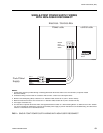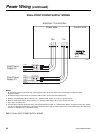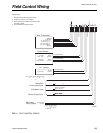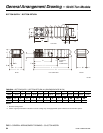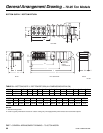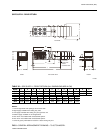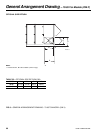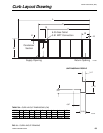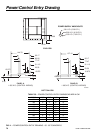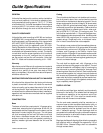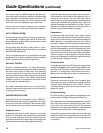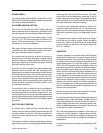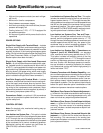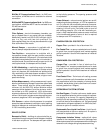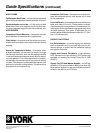
FORM 100.50-EG3 (802)
75
YORK INTERNATIONAL
BACNet IP Communications Card – for BAS com-
munications, a BACNet card is available for ethernet
connection.
BACNet MSTP Communications Card – for BAS com-
munications, a BACNet MSTP card is available for an
RS-485 connection.
IAQ OPTIONS
Filter Options – two-inch throwaway, cleanable, car-
bon or pleated filters in an angled rack are available.
Additionally, twelve-inch 65% or 95% efficient rigid fil-
ters in a flat rack with two-inch prefilters. For
field-supplied filters, the unit may be ordered with a rigid
filter rack without filter media.
Manual Damper – economizer is available with a
manual damper adjustable between 0-25 percent.
Two-Position – economizer is available with a
two-position damper with the open position manually
adjustable between 0-25 percent. It is controlled via the
occupied/unoccupied signal from the unit controller. In
occupied mode, the economizer will be open and in the
unoccupied mode, the dampers will be closed.
0-100% Modulating – modulating control of exhaust
air to maintain building static pressure. Outdoor air and
return air dampers are interlocked and positioned by
fully modulating, solid state damper actuators. Control
of the damper is via a dry bulb sensor, single or com-
parative enthalpy.
Airflow Measurement – airflow measurement is avail-
able for the Modulating Damper Economizer option listed
above. Three options exist for airflow measurement;
minimum, full and 25%/75% airflow. Minimum airflow
measures airflow between 0 and the minimum ventila-
tion airflow up to 25% outside air. 100% airflow mea-
surement measures air flow from 0-100% of the outside
airflow. A third option includes a two-stage airflow mea-
surement; stage one 0-25% and stage two 25-100%.
CO
2
Sensors – carbon dioxide sensors for occupied
space that operate demand ventilation control opening
outside air dampers to ventilate building. Available with
0-100% modulating economizer.
RELIEF SYSTEM
Barometric Relief – building air exhaust shall be ac-
complished through barometric relief dampers installed
in the return air plenum. The dampers will open relative
to the building pressure. The opening pressure shall
be adjustable.
Power Exhaust – exhaust control options are on/off,
modulating discharge damper, or VFD fan speed con-
trol. On units with non-modulating exhaust a baromet-
ric relief damper is included to prevent outside air from
entering in the off cycle. Fans shall cycle on and off
with building pressure. (On units with modulating ex-
haust, a field-installed static pressure sensor mounted
in the conditioned space or return air duct is required
for damper and VFD modulation.)
EVAPORATOR COIL PROTECTION
Copper Fins – provided in lieu of aluminum fins.
Pre-Coated Fins – an epoxy-coated aluminum fin stock
to guard from corrosive agents and insulate against
galvanic potential. Used for mild seashore or industrial
locations.
CONDENSER COIL PROTECTION
Copper Fins – provided in lieu of aluminum fins.
Pre-Coated Fins - an epoxy-coated aluminum fin stock
to guard from corrosive agents and insulate against
galvanic potential. Used for mild seashore or industrial
locations.
Post-Coated Fins – Technicoat coil-coating process
used on condenser coils for seashore and other corro-
sive applications (with the exception of strong alkalis,
oxidizers, wet bromide, chlorine and fluorine in concen-
trations greater than 100ppm).
REFRIGERANT SYSTEM OPTIONS
Hot Gas Bypass – Permits continuous, stable opera-
tion at capacities below the minimum step of compres-
sor staging to as low as 5% capacity (depending on
both the unit and operating conditions) by introducing
an artificial load to the evaporator coil. Hot gas bypass
is standard on refrigerant system #1 on VAV units; avail-
able as an option on constant volume.
Replaceable Core Liquid Line Driers – liquid line dri-
ers are standard on the eco
2
rooftop unit. An option is
provided for replaceable core driers.
Compressor Isolation Valves – optional ball valves
installed in the compressor suction and discharge lines
allow easier access to the compressors without having to
remove the unit charge during compressor servicing.



